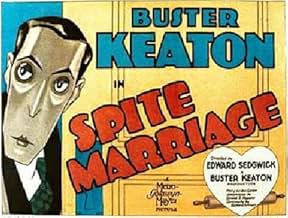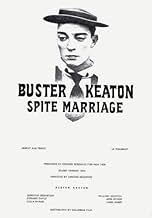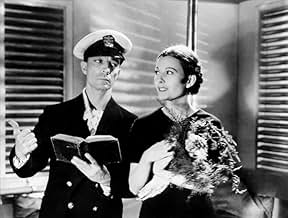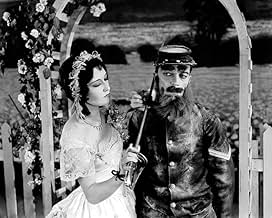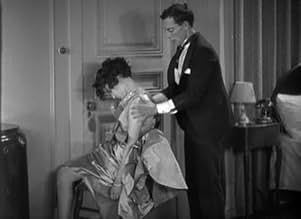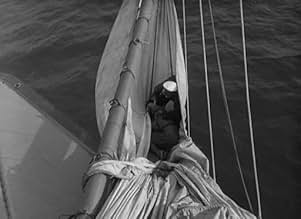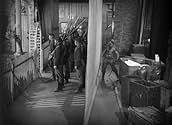Ein unscheinbarer, aber gutmütiger Mann erhält die Chance, eine berühmte Schauspielerin zu heiraten, deren hoffnungsloser Fan er ist. Ihm ist jedoch nicht klar, dass er nur dazu benutzt wird... Alles lesenEin unscheinbarer, aber gutmütiger Mann erhält die Chance, eine berühmte Schauspielerin zu heiraten, deren hoffnungsloser Fan er ist. Ihm ist jedoch nicht klar, dass er nur dazu benutzt wird, den Verflossenen der Schauspielerin eifersüchtig zu machen.Ein unscheinbarer, aber gutmütiger Mann erhält die Chance, eine berühmte Schauspielerin zu heiraten, deren hoffnungsloser Fan er ist. Ihm ist jedoch nicht klar, dass er nur dazu benutzt wird, den Verflossenen der Schauspielerin eifersüchtig zu machen.
- Regie
- Drehbuch
- Hauptbesetzung
- Giovanni Scarzi
- (as John Byron)
- Rumrunner
- (Nicht genannt)
- The Bellboy
- (Nicht genannt)
- Man in Ship's Engine Room
- (Nicht genannt)
- Tugboat Captain
- (Nicht genannt)
- Man in Audience Next to Elmer
- (Nicht genannt)
- Actor as 'Union Officer'
- (Nicht genannt)
- Stage Manager
- (Nicht genannt)
- Tough Sailor
- (Nicht genannt)
Empfohlene Bewertungen
The original score is fantastic, here - it includes a great deal of popular music and makes commentary on the situations, but the meaning will be lost on most modern viewers (I collect records from that period, so I recognize most all of it); even so, it moves the action right along and gives us a rare chance to experience a silent film just as it was presented to contemporary audiences. No cheesy piano accompaniment, here! The sound effects are well done, and used sparingly.
The shipboard scenes could have been trimmed a bit; they seem to drag. Otherwise, time flies during this movie - you won't regret watching it! Just compare it with the average sound 'comedy' which Hollywood produced until 1932 or so, and you'll realize how they lost the art of making good films for a while. It's a crime that Keaton wasn't given the chance to produce his own talkies, because he might have changed the whole concept of what made a good SOUND comedy! It's a wonder that audiences didn't rebel against the boring, static, yawnful talk-fests that early sound comedies became; maybe the novelty of Talkies really WAS enough to bring them into the theaters.
I'd haven given this a 10, except for the draggy ship scenes - but the ending is satisfyingly Keatonesque!
Co-star Dorothy Sebastian deserves a medal both for her performance and for putting up with being knocked about so.
So many of Keaton's leading ladies get treated very physically, surely part of the auditions was a test of their good-natured sportsmanship -- and probably their physical conditioning, too.
Dorothy Sebastian's character is not very sympathetic at first, but she learns, and when she has to assist in her own rescue, she is adorable, cute as the proverbial button.
Keaton, though, is the real reason to watch, this or almost everything else he is in.
He ranks among the top of the certifiable geniuses of motion picture making, with an unfailing sense of timing, with uncanny physical control, and with an understanding of what was (and is) funny that the studio bosses of his latter career should have paid attention to.
Even with the worst material, with which he was saddled in so many of his talkies, Keaton and his abilities and talents still stand out, are still memorable.
Buster Keaton will deserve our awe forever.
He has abruptly grown into those strong bones at last. The alteration is not unbecoming, but it's undoubtedly somewhat marked.
As to why, precisely, I found myself speculating so extensively during the first half of the film on the changes in Keaton's personal appearance... I'm afraid it was because I didn't find it very funny.
The opening scenes have their moments, certainly. Dorothy Sebastian gets good material and can act, and so can Keaton -- when he's allowed. But too much of the humour I found simply to be farcical clowning: in an earlier film, the routine with the hats, for example, might have lasted a second or so for a throwaway laugh, but here it's milked far beyond what it can bear, and much of the other business I felt to be equally forced. There are moments that fly past with Keaton's old lightness of touch, such as the revelation of the true source of his elegant clothing, but there seems to be a general feeling that if a joke is worth doing once, it is worth labouring to death.
The sequence in which 'Elmer' disrupts the performance of the Civil War melodrama was, for me, more a matter of cringing than laughter; it's only fair to say that these sentiments were very definitely not shared by those in the seats nearby, and it may well just be a case of my aversion to the destructive nature of slapstick humour. But what I love about Keaton isn't his ability to fall over things and knock things down -- any comic worth his salt can do that -- it's the ingenuity and resourceful illogic of his invention at its best, and there's precious little of that on show here.
Fortunately, matters improve thereafter, as he is allowed a little more resource. Miss Sebastian shines during the restaurant scene, with Buster as second fiddle, and he is able to advance his relationship with his 'wife' during this section of the film into something a little more complex than fatuous knock-kneed idolatry. I have to confess that I didn't find the scene where he tries endlessly to put her to bed to be as classic as it's apparently held, although I did appreciate his typically Keatonesque solution to the chair problem, but the film definitely picks up from around this point.
The real enjoyment for me, however, only started when Elmer and the girl are left alone on the yacht together; it's almost as if a script that has been written to date by somebody else is taken over by an inspiration that's characteristically Keaton's, as both he and his character rise to the occasion. It occurs to me in passing to wonder if isolation of the filming crew aboard the yacht could possibly have helped foil studio interference..? But maybe it's simply that this is the Keaton we're used to, coming up with wonderfully complex schemes, disabling an entire crew of villains one by one or launching himself intrepidly into the unknown mysteries of the rigging. I was struck by the difference in tone between the sympathetic comedy of this section, where he tries to reduce sail with the help of the girl and the handicap of their joint ignorance, and the earlier, clumsy, 'varnishing' sequence, in which he is purely inept and we are expected to find it funny.
If the 'adrift alone' theme echoes "The Navigator", then the final knock-down fight inevitably recalls "Battling Butler"; as in that film, Keaton produces not only an athletic but a well-acted confrontation, as Elmer faces up to an opponent tall enough and strong enough to hold him ineffectual at arm's-length... armed only with bantam courage, and the luck and resolve that enable him to survive and keep coming back for more even as he visibly tires. And the payoff in the final line of this scene repaid, for me, all the clumsy physical clowning of the stage scenes earlier! (I must add that as a satire on overwrought drama, I actually find the depiction itself of the play "Carolina" quite funny; it's Buster's distinctly unsubtle involvement that grates on me so.)
At the start of "Spite Marriage", I'd have been hard put to rate it above a wavering 5 or 6, with the low comedy of scenes such as the riding encounter definitely toward the low end of that scale. I was pleasantly surprised to find it veering upwards as it went on, into the territory of 7 or above, and the ending I'd generally rate at an 8. (The return of the hat gag, I have to say, was not to my taste!) However, I cannot in all conscience give the film as a whole a ranking above about seven on my personal scale: worth watching, worth recommending to others, but not really worth going through discomfort or inconvenience to see.
Edit: re-watching this film with the original soundtrack (the love theme, "I'm Afraid of You", is certainly appropriate!), I'm impressed above all by Dorothy Sebastian's performance; now that I've seen his later work, Keaton's performance and material here actually reminds me more of his sound-era pictures. You may not be able to hear his voice, but you can certainly see a lot of the same mannerisms appearing...
In this one, he plays a hapless Romeo, devoted to stage actress Dorothy Sebastian. He sees her every performance and brings her bouquets of roses. The only trouble is Dorothy's in love with her costar; but when he marries someone else, she gets even by marrying Buster out of spite. The story jumps around quite a bit, so you might think you're seeing three movies in one. The first part of the film takes place in the theater, in the second part, Buster falls in with a crowd of gangsters, and in the final third, Buster and Dorothy are the only survivors on a sinking ship. While it might seem random, you won't have time to question it because you'll be mesmerized by Buster's incredible stunt work. He hangs from a rope on the mast, repeatedly gets thrown overboard only to catch himself on the boom and leap back on deck, and even falls into the sail and has to pull himself back up. Dorothy is a real trouper, participating in many of his stunts and gags, including the famous bedroom skit, recreated later by Buster and his wife onstage and by Donald O'Connor and Ann Blythe in The Buster Keaton Story. This movie feels like a very fond farewell to Buster Keaton's silent pictures, with all the elements of his famous films thrown together: a lovesick hero, dangerous stunts, funny gags, and a ship. Really the only thing missing is a train, but you can find one in almost every other of his movies.
Elmer Gantry (Keaton) runs a laundry, which allows him plenty of time and access to fine clothes for stalking in the guise of a rich suitor stage star Trilby Drew (Dorothy Sebastian). Trilby attaches herself to fellow star player Lionel Benmore (Edward Earle), but when Benmore takes up with a society beauty, Trilby decides to marry Elmer to show him up, to her later regret.
"Spite Marriage" is Keaton's last silent comedy (except for a short called "The Railrodder" he made near the end of his career). It's better than several of the features he made before being picked up by MGM the year before, specifically "College," "Go West," "Three Ages," and "The Saphead." But it falls short of classic Buster, often because of the role played by Buster himself.
For almost all of the first 30 minutes, viewers have to adjust to the novel notion of Buster the idiot. After an abrupt opening, we see Buster fumbling around on horseback, wiggling lovelorn in his seat as Trilby performs on stage, and finally sneaking on stage to make a mess of the show. It is funny, but in a frustrating, jerky way.
Too often the film calls attention to Buster's fish-out-of-water character, particularly when he joins the cast and stumbles over assorted props, to the annoying amusement of the audience. In his earlier films, Buster was a stoic victim of mayhem, rather than producing it himself. This made the comedy work without lessening the character. Here, you can't help but emphasize with the theatrical agent who moans: "Shoot him! They'll think it's part of the act!"
There are also odd bits of sympathy trolling. We see him bring her a stuffed dog doll with a tear running down one eye. After he discovers Trilby has left him, the camera lingers on the doll one last time, as an overt nod to Elmer's pitiful state. It's like something out of Harry Langdon.
But there are compensations throughout the early part. Trilby's play, "Carolina," is a wonderful send-up of theatrical conventions. When Lionel makes his entrance as a wounded fugitive, he stops to acknowledge the applause. "A scratch is nothing to a Southern gentleman," he tells Trilby's character, a goofy line that gets a nifty callback late in the film.
Sebastian is a big part of why "Spite Marriage" works as well as it does. For the first time, I watched a Keaton feature not pining for Sybil Seely. Trilby is no gentle flower, but rather a scheming, petty character who uses Elmer's affection for her own ends. As an ex-spite boyfriend, I could relate to this. Most important, she is very funny, especially in a scene in a speakeasy where she gets drunk and loses her cool when she sees Lionel with his new babe. It's a great use of Buster's expressionless manner by director Edward Sedgwick and the MGM team, playing it off Sebastian's scowling and histrionics. She also takes a fall as well as Buster, which helps.
The movie's most famous scene uses her athleticism to splendid effect, where he tries to put his unconscious bride to bed. He tries to sit her on a chair, only to have her roll off. As other reviewers here note, it's easy to ignore the effort she must put forth, keeping Buster hopping without apparently moving a muscle.
The finale, aboard a yacht, is the film's best sequence. Ironically, as historians John Bengtson and Jeffrey Vance note in their helpful DVD commentary, this was one part of the movie Buster didn't want to do, probably concerned he was repeating "The Navigator." But "Spite Marriage" takes the same idea in different directions, and most importantly, ramps up the laughter while giving us Buster in take-charge form. A key bit of business involves his wearing a captain's hat, which seems to signal a sense of newfound authority for the performer.
Alas, it was not to be. Buster's subsequent work for MGM, while quite profitable, would run the gamut from weak to awful, with Buster himself anything but in charge. "Spite Marriage," with its misplaced emphasis on poor, stupid Elmer, would inaugurate this trend, but it's more of a piece with his days as silent comedy's master clown. Keep this in mind, and you will have a good time.
Wusstest du schon
- WissenswertesBuster Keaton wanted this film to be a full talkie, but MGM released it with only a musical score and sound effects. One thing that prevented this picture from being a full talkie was that MGM was late to the sound game and had only one full set of recording equipment at the time. Its Loew's Theater chain also was not yet fully equipped to show sound pictures. Plus, MGM's head of production reasoned Keaton's films were made with a lot of time-consuming improvisations and didn't think the added expense of using valuable, scarce sound equipment was worth it.
- PatzerIn the dressing-room, while attempting to trim the hair for his false beard, Elmer accidentally severs the left-hand shoulder strap of his tank-top undershirt and has no time to repair it. When he hurriedly changes back into his smart clothes after the performance, both straps are still whole.
- Zitate
Trilby Drew: What's that blonde hanging around you for?
Lionel Benmore: Can I help it if I'm good-looking?
- Crazy CreditsRather than appear at the beginning, the MGM roaring lion opening appears after the conclusion of the film, but just before "The End" title, which immediately follows it.
- VerbindungenFeatured in Arena: Cinema: Christmas Special (1976)
- SoundtracksI'd Rather Be Blue Over You
(uncredited)
Music by Fred Fisher
Lyrics by Billy Rose
Played as background music at the cafe
Top-Auswahl
- How long is Spite Marriage?Powered by Alexa
Details
- Erscheinungsdatum
- Herkunftsland
- Sprachen
- Auch bekannt als
- Trotzheirat
- Drehorte
- Hotel Carmel - 201 Broadway St, Santa Monica, Kalifornien, USA(Lionel confronts Buster outside this hotel on the 2nd Street side - still in business in 2022)
- Produktionsfirma
- Weitere beteiligte Unternehmen bei IMDbPro anzeigen
- Laufzeit
- 1 Std. 16 Min.(76 min)
- Seitenverhältnis
- 1.33 : 1

